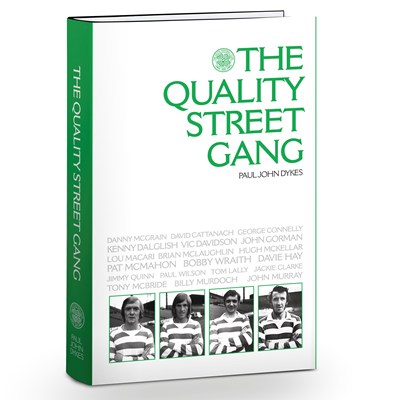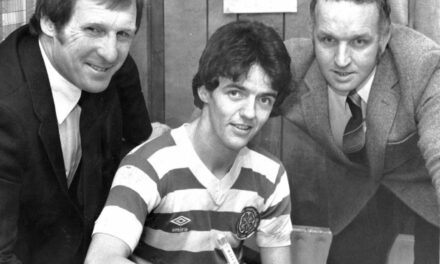I have a confession to make; since I knew this book was in the making I have desperate to read it. A few years ago the author Paul Dykes declared on the hallowed portal of the Kerrydale Street website that he was in the process of writing a book about Celtic’s greatest ever crop of young players. Ever since then I have been keenly anticipating it’s arrival.
This book details the story of a bygone age when a collection of promising youngsters joined Celtic in the 1960’s and became the most talented reserve side that Scottish football has ever had the privilege of witnessing.
Reserve football was very strong back then, so much so that I can vividly recall buying the Evening Times or Evening Citizen on a Saturday night just to discover how the reserves had fared on that day. The Celtic View of the period was also compulsive reading as Sean Fallon kept the fans up to speed each week with the progress of the second eleven. Despite being a level below first team football these games were taken seriously and the fans liked nothing more than seeing capable young players emerging from the ranks.
The Quality Street Gang as they became known were not only fortunate to have Fallon and Jock Stein coaching them they also had the pleasure of training with the Lisbon Lions who by all accounts are portrayed as being very good at sharing their experiences and giving their time to the youngsters. Kenny Dalglish, for one, should have had ‘made at Celtic’ tattooed on him. In his time at Parkhead he inherited the passing skills of Murdoch, the guile of Auld and the competitive spirit of Wallace which as we all know now was a potent mixture indeed.
For a period during the Stein era Celtic played their home reserve games on a Friday night to allow the fans the opportunity of coming along to watch the boys play and lend their encouragement to them. In doing so these games often drew impressive crowds, so much so that there were moves afoot to have the Celtic reserve side placed in lowest level of the Scottish league but this was deemed as unacceptable at that time by the football authorities.
In 1968 Celtic reserves were placed in a league cup section and had to win their last game against Partick by seven goals. On the day they ended up winning by an incredible score line of 12-0 and as the years passed by their reputation increased greatly. As a team they peaked in 1971 when they annihilated Rangers in the reserve league cup final over two legs, by 7-1 and 4-1 respectively, as the country began to take note of such names as Macari, Dalglish and Davidson.
The beauty of this book isn’t reading about the legendary figures of McGrain, Dalglish and Hay, the great thing is learning about some of the very talented boys who didn’t make it, players like Hugh McKellar, John Murray, Jackie Clarke and Ward White. White never played for the first team but recalls how tantalisingly close he came to playing against Inter Milan in the San Siro in a European Cup semi final due to an injury crisis. Things may not have worked out ideally for some of the ‘gang’ but they all have a fascinating story to tell and all of them come over as having had a very happy and enjoyable experience in Paradise.
Reading the book filled me with a certain amount of sadness. These boys should have been the back bone of the Celtic side for years to come but some of them didn’t develop as was hoped whilst others like Macari, Hay and Dalglish chose to take the lucrative road south to the major English clubs.
George Connelly’s sad demise is well documented and the late Brian McLaughlin’s talents are recalled fondly. McLaughlin was rated better than Dalglish at an early age only for a disgraceful tackle to virtually end his Celtic career and prevent him becoming a possible all time great. The culprit who tackled Brian is not mentioned by name in the book and won’t be mentioned in this article either.
Perhaps the saddest tale of all is that of Tony McBride, who in 1967 was the most sought after teenager in British football after tearing England schoolboys apart at Wembley. Virtually every major British team chased McBride before he opted for Parkhead and his boyhood idols. McBride is very frank in his recollections and, sadly, appears to have had his demons to contend with in his youth. By 1971 he was not only lost to Celtic but to football in general and that was a tremendous waste of talent. In later years I can recall my father and his friends discussing McBride and it is astonishing that a player who never played a single game in Celtic’s first team could be spoken of in such revered tones years later.
My only concern about this book is that it may have limited appeal to a certain age group and that younger Celtic fans may feel it is not of interest to them. This is not the case. This book is well written and has clearly been thoroughly researched and is a great read from first page until last. I would recommend buying it for the quality of pictures alone. These days it’s difficult to see photos in a Celtic book which haven’t been seen before but there are many delightful images in here that are shown in print for the first time.
At the book launch at Celtic Park Davie Cattanach gave a moving speech in which he recalled his pride of captaining the Quality Street Gang and of how it didn’t matter if you played for the Celtic first team, the reserves or the third side, standards had been set and you were expected to win. Paul Dykes’ story reflects a refreshing age when Celtic players played for the jersey and were made to count themselves as fortunate in doing so.
The Quality Street Gang took a long time to see the light of day and let it be said it has been well worth the wait and it appears to have been a labour of love for the author. I have a library of around 150 Celtic books which I have gathered over the years and I can confirm that this book is amongst the very best I have ever read, right up there with the best publications that Campbell, Woods and Potter have provided us with over the years.
It deserves to be a tremendous success and catalogues a delightful period in Celtic’s history which has now thankfully been documented in the detail it merits.



